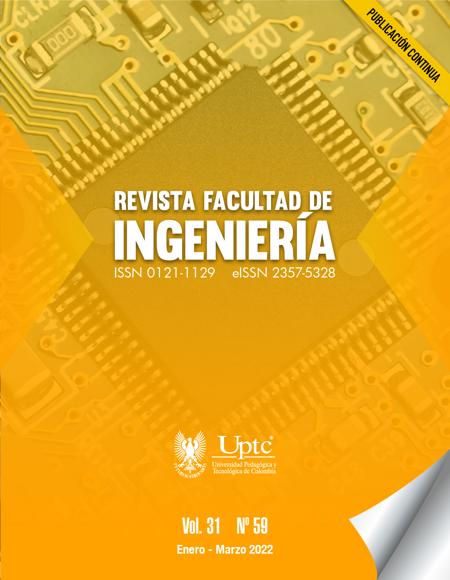Mathematical Analysis of Discontinuous Rectification Columns at Pilot Scale Based on the Continuous Stable States Concept and MESH Equations

Abstract
Mathematical analysis and simulation of a discontinuous rectification column was performed using an operational strategy during the start-up before reaching a pseudo-stable state in discontinuous operation. The mathematical model was formulated focusing on the equilibrium state (ES) and implementing MESH equations (M: Mass balance, E: Equilibrium thermodynamics, S: Stoichiometry relations, H: Enthalpy or heat balance) to provide solutions using the Thomas method and the Wang-Henke algorithms internally coupled to the Fourth Order Runge-Kutta method. The results were validated with experimental data from a distillation column at a pilot scale using an ethanol-water system with an equilibrium behavior described by the UNIQUAC Functional-group Activity Coefficients (UNIFAC) and Predictive Soave-Redlich-Kwong (PSRK) thermodynamic models with a global error of 1.84%. The molar ethanol concentrations presented deviations from the mathematical model predictions from 1.51% to 0.02%, with a global mean error of 0.48%. A mean error of 0.055% was obtained for the temperature profile of the column, thus demonstrating the effectiveness of the solution and its convergence capacity. The solution based on the Thomas method and the Wang-Henke algorithms coupled to the Runge-Kutta method made it possible to describe the behavior and variables of all stages of the distillation column. Operation at total reflux from start-up avoids wasting product and allows for the stabilization of the state variables, such as temperature and molar composition.
Keywords
PSRK method, Thomas algorithm, UNIFAC model, UNIQUAC model, Wang-Henke algorithm
Author Biography
Jennyfer Diaz-Angulo
Roles: Conceptualization, Data curation, formal analysis, investigation, methodology, validation, writing - original draft.
Alfonso Barbosa-Meza
Roles: Data curation, investigation, methodology, validation.
Fiderman Machuca-Martínez
Roles: Formal analysis, Resources, Software, Supervision.
Miguel-Ángel Mueses
Roles: Formal analysis, Project administration, Supervision, Visualization, Writing - review and editing.
References
- M. D. López-Ramírez, F. O. Barroso-Muñoz, J. Cabrera-Ruiz, J. G. Segovia-Hernández, H. Hernández-Escoto, S. Hernández, “Some insights in experimental studies on the start-up operation of a reactive dividing wall column,” Chemical Engineering and Processing-Process Intensification, vol. 159, e108211, Feb. 2021. https://doi.org/10.1016/j.cep.2020.108211 DOI: https://doi.org/10.1016/j.cep.2020.108211
- S. Elguea, L. Prata, M. Cabassuda, J. M. Le Lann, J. C´ezeracb, “Dynamic models for start-up operations of batch distillation columns with experimental validation,” Computers and Chemical Engineering, vol. 28, no. 12, pp. 2735–2747, Nov. 2004. https://doi.org/10.1016/j.compchemeng.2004.07.033 DOI: https://doi.org/10.1016/j.compchemeng.2004.07.033
- I. Thomas, B. Wunderlich, S. Grohmann, “Pressure-driven dynamic process simulation using a new generic stream object,” Chemical Engineering Science, vol. 225, e115171, Apr. 2020. https://doi.org/10.1016/j.ces.2019.115171 DOI: https://doi.org/10.1016/j.ces.2019.115171
- J. R. González-Velasco, M. A. Gutierrez-Ortíz, J. M. Castresana-Pelayo, J. A. Gonzalez-Marcos, “Improvements in batch distillation start-up,” Industrial & Engineering Chemistry Research, vol. 26, no. 4, 745–750, Apr. 1987. https://doi.org/10.1021/ie00064a020 DOI: https://doi.org/10.1021/ie00064a020
- L. Wang, P. Li, G. Wozny, S. Wang, “A start-up model for simulation of batch distillation starting from a cold state,” Computers & Chemistry Engineering, vol. 27, no. 10, pp. 1485–1497, Oct. 2003. https://doi.org/10.1016/S0098-1354(03)00094-2
- E. Yamal, O. Martínez, “Simulación dinámica de una torre de destilación de platos perforados,” Revista Ingeniería UC, vol. 16, no. 1, pp. 65-70. Apr. 2009
- E.J. Henley, D. J. Seader, Separation operations by Equilibrium Stages in Chemical Engineering, UItah, United State, Ed. Reverte S.A., 1997
- M. Markowsky, S. Alabrudzinski, S. Storczyk, “Heat and mass exchanger model for hybrid heat integrated distillation systems (HHIDiS),” Applied Thermal Engineering, vol. 174, no. 25, e115249, Jun. 2020. https://doi.org/10.1016/j.applthermaleng.2020.115249 DOI: https://doi.org/10.1016/j.applthermaleng.2020.115249
- M. Chai, M. Yang, R. Qi, Z. Chen, J. Li, “Vapor-liquid equilibrium (VLE) prediction for dimethyl ether (DME) and water system in DME injection process with Peng-Robinson equation of state and composition dependent binary interaction coefficient,” Journal of Petroleum Science and Engineering, vol. 211, e110172, 2022. https://doi.org/10.1016/j.petrol.2022.110172 DOI: https://doi.org/10.1016/j.petrol.2022.110172
- J. Jaubert, R. Privat R, “Relationship between the binary interaction parameters (kij) of the Peng–Robinson and those of the Soave–Redlich–Kwong equations of state: Application to the definition of the PR2SRK model,” Fluid Phase Equilibria, vol. 295, no. 1, pp. 26–37. Aug. 2010. https://doi.org/10.1016/j.fluid.2010.03.037 DOI: https://doi.org/10.1016/j.fluid.2010.03.037
- E. Boonaert, A. Valtz, C. Coquelet, “Vapour-liquid equilibria of n-butane and ethyl mercaptan: Experiments and modeling,” Fluid Phase Equilibria, vol. 504, e112335, Jan. 2020. https://doi.org/10.1016/j.fluid.2019.112335 DOI: https://doi.org/10.1016/j.fluid.2019.112335
- J. M. Smith, H. C. Vann Ness, M. M. Abbott, Introducción a la termodinámica en Ingeniería Química, 7ª Ed. Mexico DF, McGraw Hill, 2007
- E. Jara, D. Collado, M. De la Cruz, V. C. M. Vivas, “Dynamic simulation of bioethanol in batch régimen,” Tecnia, vol. 21, no. 1, pp. 56-72. Jun. 2011. https://doi.org/10.21754/tecnia.v21i1.95 DOI: https://doi.org/10.21754/tecnia.v21i1.95
- L. Wanga, W. Gunter, S. Wang, “A startup model for simulation of batch distillation starting from a cold state,” Computers & Chemical Engineering, vol. 27, no. 10, pp. 1485-1497, Oct. 2003. https://doi.org/10.1016/S0098-1354(03)00094-2 DOI: https://doi.org/10.1016/S0098-1354(03)00094-2
- M. A. Mueses, F. Machuca-Martínez, “A Solution of the Rachford-Rice Equation for Multiphase Systems by Using the Newton-Raphson Method, Broyden Parameter and the Negative Flash,” Información Tecnológica, vol. 21, no. 4, pp. 3-10, Feb. 2010. https://doi.org/10.4067/S0718-07642010000400002 DOI: https://doi.org/10.4067/S0718-07642010000400002
- R. H. Perry, Manual del Ingeniero Químico, 6ª Ed., Tomo IV, Mexico DF, McGraw Hill, 1994
- F. S. Laganier, J. H. Le Lann, X. Joulia, B. Koehret, “Simultaneous modular dynamic simulation: Application to Interconnected Distillation Columns,” Computers & Chemical Engineering, vol. 17, no. S1, pp. 287-297, 1993. https://doi.org/10.1016/0098-1354(93)80241-E DOI: https://doi.org/10.1016/0098-1354(93)85042-K
- J. Albet, J. M. Le Lann, X. Joulia, B. Koehret, “Evolutions et tendances en simulation de colonnes de rectification discontinue,” The Chemical Engineering Journal, vol. 54, no. 2, pp. 95-106, Jun. 1994. https://doi.org/10.1016/0923-0467(93)02815-E DOI: https://doi.org/10.1016/0923-0467(93)02815-E
- S. Domenech, G. Muratet, M. Enjalbert, “Commandes en Temps Minimal d’une Rectification Discontinue,” The Chemical Engineering Journal, vol. 9, no. 2, pp. 125-135, 1975. https://doi.org/10.1016/0300-9467(75)80004-9 DOI: https://doi.org/10.1016/0300-9467(75)80004-9
- S. Aly, L. Pibouleau, S. Domenench, “Traitement par une méthode d’éléments finis de modelès de colonnes de rectification discontinue à garnissage,” The Canadian Journal of Chemical Engineering, vol. 65, no. 6, pp. 991-1003, Dec. 1987. https://doi.org/10.1002/cjce.5450650615 DOI: https://doi.org/10.1002/cjce.5450650615